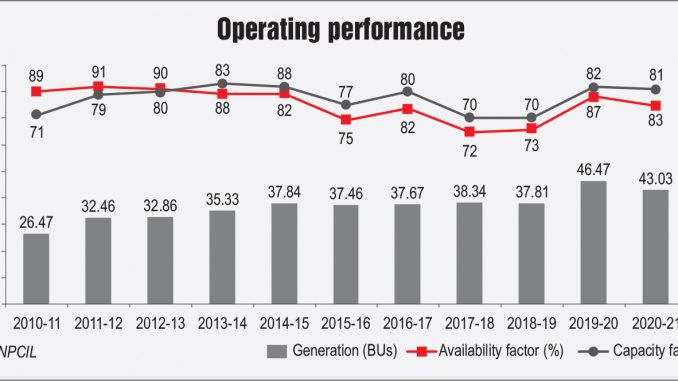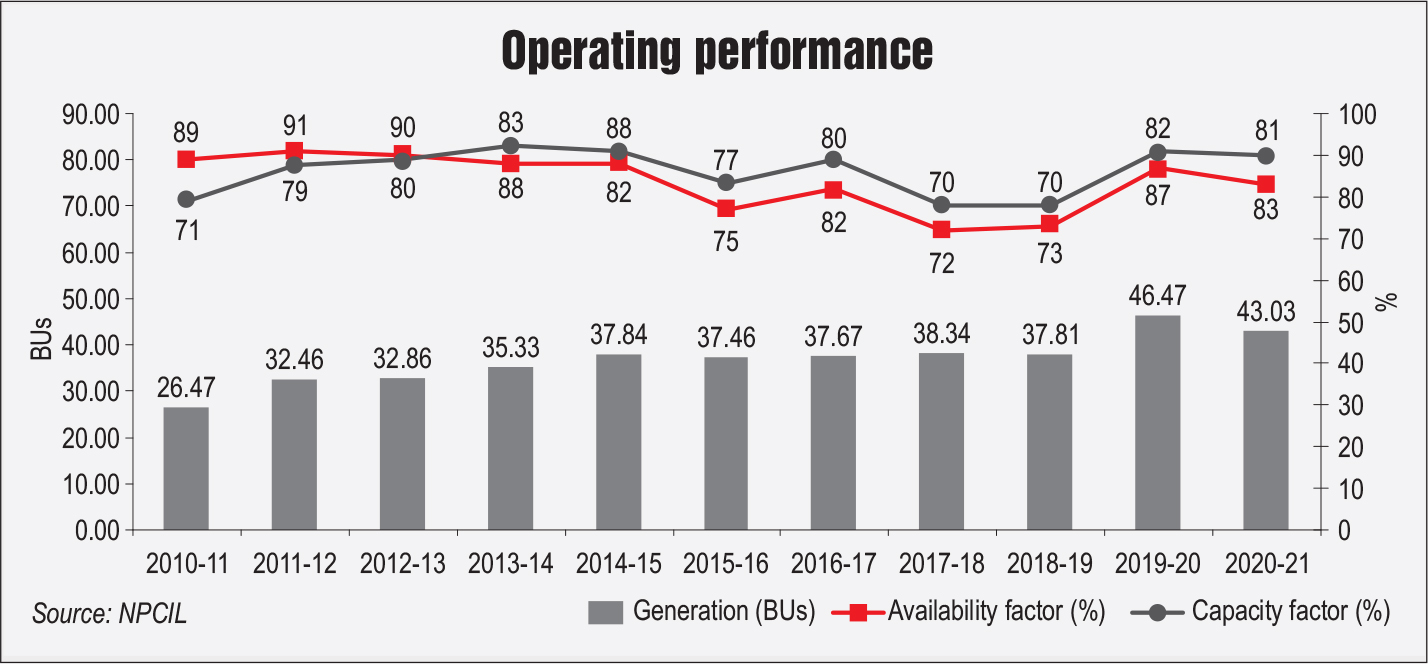
The first nuclear power plant in India began its operations in 1969 with the commissioning of a 160 MW unit at Tarapur, Maharashtra. Today, the country’s nuclear power generation capacity has grown to about 6.8 GW. It contributes roughly around 3 per cent to India’s total power generation, and less than 2 per cent of the total installed capacity. In the coming years, nuclear power is expected to play a bigger role, as India has planned that 40 per cent of its installed capacity will be based on non-fossil sources including nuclear, hydro and renewables by 2030 in order to meet its commitment under the Paris Agreement. The government’s target with respect to India’s nuclear power generation capacity is to increase it to 22.4 GW by 2031.
Capacity and operations
As of April 2021, India has a total installed capacity of 6,780 MW owned and operated by Nuclear Power Corporation of India Limited (NPCIL). In 2020-21, these units generated a cumulative 43,029 MUs at a capacity factor of 81 per cent and an availability factor of 83 per cent. The total generation decreased in 2020-21 by 7.4 per cent from 46,472 MUs in 2019-20. Of the 22 commercial nuclear power reactors across seven plants in the country, 14 reactors, with a capacity of 4,280 MW, are under International Atomic Energy Agency safeguards and use imported fuel. The remaining eight reactors, with an installed capacity of 2,400 MW, use indigenous fuel. The plants include the 1,400 MW Tarapur Atomic Power Station (Units 1-4) in Maharashtra, the 1,180 MW Rajasthan Atomic Power Station (Units 1-6), the 880 MW Kaiga Generating Station (Units 1-4) in Karnataka, the 2,000 MW Kudankulam Nuclear Power Station (Units 1 and 2) and the Madras Atomic Power Station (Units 1 and 2) in Tamil Nadu, the Narora Atomic Power Station (Units 1 and 2) in Uttar Pradesh, and the Kakrapar Atomic Power Station (Units 1 and 2) in Gujarat with 440 MW capacity each.
Upcoming projects
As per the National Infrastructure Pipeline, NPCIL will undertake a capital expenditure of about Rs 1,555 billion during 2020-25 to set up new projects. The projects under construction include Units 3 and 4 of the Kakrapar Atomic Power Project (KAPP), Units 7 and 8 of the Rajasthan Atomic Power Project (RAPP), and Units 1 and 2 of the Gorakhpur Haryana Anu Vidhyut Pariyojna, of 700 MW capacity each (total 4,200 MW); as well as Units 3 and 4 of the Kudankulam Nuclear Power Project (KNPP), of 1,000 MW capacity each (total 2,000 MW). The KAPP and RAPP units are currently under review, whereas Units 3 and 4 of KNPP are expected to be commissioned in March 2023 and November 2023 respectively. While KNPP is being implemented in association with Russian firm Rosatom and equipped with VVER-1000 reactors, four 700 MW pressurised heavy water reactor units are being indigenously developed. These include Units 3 and 4 of KAPP and Units 7 and 8 of RAPP. KAPP-3 was synchronised with the grid in January 2021. In addition, the central government has granted administrative approval and financial sanction for 10 units of 700 MW each, to be set up in fleet mode in Karnataka, Haryana, Madhya Pradesh and Rajasthan; and two units of 1,000 MW each to be set up at Kudankulam in Tamil Nadu.

French energy group EDF has also planned to build the world’s largest nuclear power plant at Jaitapur in Maharashtra, which will have a capacity of about 10 GW. Recently, in April 2021, EDF filed a binding offer to supply engineering studies and equipment for building six third-generation EPR reactors of 1,650 MW each in Jaitapur. The development follows the signing of the Industrial Way Forward Agreement between the Indian and French governments in March 2018 to enable cooperation between the two countries.
Issues and the way forward
The key reasons for the slow growth of the nuclear power segment in India are the lack of indigenous fuel and dependence on imports, coupled with high capital costs and long gestation periods. Public opposition and liability issues have also acted as deterrents in the past. However, with a pipeline of 6,200 MW of under-construction projects, the nuclear segment is expected to grow bigger in the coming years, especially given its standing as a zero-emission clean energy source.
